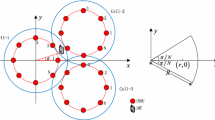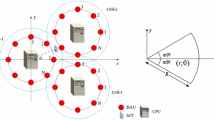Abstract
This paper focuses on the downlink system capacity in distributed antenna systems (DAS). Due to the complexity of actual wireless environments, a composite channel model is established which takes into account three factors, i.e., path loss, lognormal shadowing and Rayleigh fading. Based on the channel model, the probability density function (PDF) of the output signal-to-noise ratio (SNR) is derived. To facilitate the analysis, the distribution of the output SNR is approximated by a lognormal distribution. After that, by making use of selective diversity (SD) scheme for distributed antennas, an approximate analytical expression of the capacity for a mobile station (MS) over a given position is derived. Furthermore, considering the distribution of MSs in the system, a closed-form expression of the system capacity is obtained. Numerical results show that the closed-form expression can evaluate the system capacity performance of DAS very accurately.
Similar content being viewed by others
References
Dai L., Zhou S. D., Yao Y. (2005) Capacity analysis in CDMA distributed antenna systems. IEEE Transactions on Wireless Communications 4(6): 2613–2620
Wang, D. M., Wang, X. H., Wang, J. Z., et al. (2008). Spectral efficiency of distributed MIMO cellular systems in a composite fading channel. In IEEE international conference on communications (pp. 1259–1264). Piscataway: IEEE.
Crisp M. J., Li S., Watts A. (2007) Uplink and downlink coverage improvements of 802.11g singles using a distributed antenna network. Journal of Lightwave Technology 25(11): 3388–3395
Dai, L. (2008). Distributed antenna system: Performance analysis in multi-user scenario. In 42nd annual conference on inference sciences and systems (pp. 85–89). Princeton: Computer Society.
Castanheira D., Gameiro A. (2010) Distributed antenna system capacity scaling. IEEE Wireless Communications 17(3): 68–75
Shi, C., Wang, Y., Wang, T., et al. (2010). Resource allocation for heterogenerous services per user in OFDM distributed antenna systems. In IEEE 71st vehicular technology conference. Taiwan: IEEE
You X. H., Wang D. M., Sheng B. et al (2010) Cooperative distributed antenna systems for mobile communications. IEEE Wireless Communications 17(3): 35–43
Wang, J. Y., Wang, J. B., Chen, M., et al. (2011). System outage probability analysis of uplink distributed antenna systems over a composite channel. In IEEE 73rd vehicular technology conference. Budapest: IEEE.
Roh, W., & Paulraj, A. (2002). MIMO channel capacity for the distributed antenna systems. In IEEE vehicular technology conference (pp. 706–709). Vancouver: IEEE.
Zhuang H. R., Dai L., Xiao L. et al (2003) Spectral efficiency of distributed antenna system with random antenna layout. IEE Electronics Letters 39(6): 495–496
Feng, Z. H., Jiang, Z. J., Pan, W., et al. (2008). Capacity analysis of generalized distributed antenna systems using approximation distributions. In 11th IEEE Signapore international conference on communication systems (pp. 828–830). Piscataway: Computer Society.
Chen, H. M., & Chen, M. (2009). Capacity of the distributed antenna systems over shadowed fading channels. In IEEE 69th vehicular technology conference. Barcelona: IEEE.
Qian, Y. Z., Chen, M., Wang, X. Z., et al. (2009). Antenna location design for distributed antenna systems with selective transmission. In International conference on wireless communication and signal processing. Piscataway: IEEE.
Li, X., Luo, M. S., Zhao, M., et al. (2009). Downlink performance and capacity of distributed antenna system in multi-user scenario. In 5th International conference on wireless communications. Networking and mobile computing. Piscataway: Computer Society.
McDonough R. N., Whalen A. D. (1995) Detection of signals in noise (2nd ed.). Academic Press, California
Goldsmith A. (2005) Wireless communication. Cambridge University Press, New York
Papoulis A. (1991) Probability, random variables and statistic processes (3rd ed.). McGraw-Hill Companies. Inc., New York
Stuber G. L. (1996) Principles of mobile communication (2nd ed.). Kluwer Academic Publishers, Dordrecht
Abramowitz M., Stegun I.A. (1970) Handbook of mathematical functions with formulas, graphs, and mathematical tables (9nd ed). Dover Publications, New York
Burden R. L., Faires J. D. (1989) Numerical analysis (4th ed.). PWS KENT Publishing Company, Boston
Author information
Authors and Affiliations
Corresponding author
Rights and permissions
About this article
Cite this article
Wang, JB., Wang, JY. & Chen, M. Downlink System Capacity Analysis in Distributed Antenna Systems. Wireless Pers Commun 67, 631–645 (2012). https://doi.org/10.1007/s11277-011-0401-9
Published:
Issue Date:
DOI: https://doi.org/10.1007/s11277-011-0401-9




